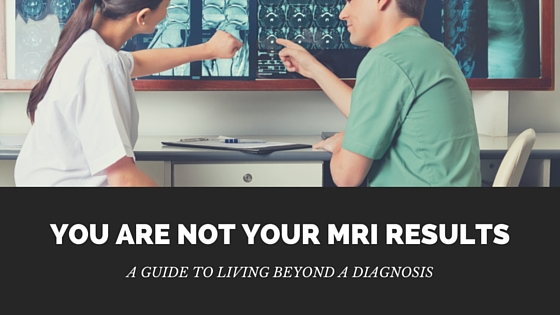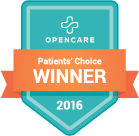You Are NOT Your MRI: A Guide for Living Beyond a Diagnosis

Last week I posted this on Facebook, and it generated a lot of feedback so I figure it’d make a good blog post:
Just a reminder for you:You are NOT your MRI and you are NOT your diagnosis.You are a human being with resiliancy and a powerful ability to heal. Don’t let anyone tell you otherwise.
Posted by Keystone Chiropractic Wellington on Friday, October 16, 2015
I made this post because of 2 new patients that came into the office this week. One had really bad neck pain, and the other had really bad back pain. Both came in with MRIs and reports showing severe disc herniations, spinal stenosis, and nerve root encroachment. Both had seen doctors who told them that they would need surgery in order to get better.
Long story short, within days of their first Atlas correction, they both felt better than they had in years. Both had more energy, were sleeping better, and stopped taking their over the counter pain meds because they felt virtually pain free.
Now I’m not saying this to toot my horn, or say how great I am (well…maybe just a little bit), but the big idea I want to convey today is that you are not simply the end product of our imaging findings or diagnosis.
You are a human being. That means that as long as you have life coursing through your nerves, and blood flowing through your veins, you were born with resiliancy and a powerful ability to heal.
Living Beyond Your Diagnosis
Before I move forward, I want to make it clear that I’m not saying that your diagnosis is irrelevent or isn’t important.
However, the longer that I’m in practice, the more I realize that patients consistently have better outcomes when they begin to separate their diagnosis from their identity. Too often, I run into people who stop doing things in their lives because they are someone with “x” condition.
Here are some examples of what I’m talking about:
- “I used to love running, but I can’t do it anymore because I have arthritis in my knees”
- “I’m not going to lift weights anymore, I have a herniated disc”
- “I shouldn’t go to my grandson’s basketball game, my vertigo might hit me”
- I shouldn’t go to the pizza place with you guys, I might breathe in gluten
Alright, so that last one was probably a stretch, but you get my point.
Everyday, thousands of people are walking into doctors’ offices and receiving a diagnosis for their incurable or difficult to treat condition. A diagnosis is supposed to help a doctor or health care professional develop a plan or treatment strategy for the patient. It’s not supposed to make a patient forget that they are a living, breathing human being, and the thing that led human beings to the top of the food chain is our remarkable ability to ADAPT.
When we remember that we have this adaptability, it allows us to change our mindset from being a victim of our diagnosis, to seeking ways to live in spite of our diagnosis.
Just check out this short video of Steph Hammerman, a woman with cerebral palsy who has EMBRACED of all things…..Crossfit
And Stephanie is far from the only person who has found ways to live beyond her disability, there are literally hundreds of wounded warriors with missing limbs, PTSD, and more who are doing mud runs and showing that a living human being can push their limits.
Now these are certainly examples from the extremes, so it might be hard to relate to that story, or maybe they are just made of a tougher mental attitude than you think that you possess. I don’t think that’s the case, so I compiled a list of things that I’ve observed seem help people live beyond their diagnosis.
- Most people that live beyond their diagnosis are motivated by an activity that they love, or feel like they can’t live without. Here in Wellington, that usually means golf or equestrian activities. When you have an activity that you love, you are willing to do the hard work that it takes to rehabilitate yourself from an injury.Find an activity that motivates you. It might be dancing, it might be Crossfit, it might be walking your daughter down the aisle, or making love to your significant other. When something important to you is on the line, you will work hard to find a way to make yourself functional.
- There’s a reason why many of the people you see overcoming a challenging disability are former military personnel. When you talk to them, many have an attitude that they have something to prove. Some want to prove to their doctor, friends, or family that they can still perform at a high level. For others, they want to prove to themselves that they still have value as a contributing individual to society.Carrying a chip on your shoulder is not the most noble means of reaching a goal, but the ones that carry that chip refuse to let outside circumstances dictate how they want to live their life.
- One of the coolest and most burdensome things about being a NUCCA Structural Chiropractor is that a lot of people with chronic pain and illness can start to feel better very quickly. The cool part is that the patient is really happy that they get their life back and refer like crazy. The burdensome part is that everyone they refer tends to have the expectation that they are going to get better just as quickly.In moments like that, I have to remind people during a health history/consultation to celebrate the little victories. There’s nothing worse than going in with high expectations for a quick fix, only to go through the process frustrated with small incremental improvements.Often times, it’s the people who experience the small, incremental improvements that experience the more long-lasting and sustainable results. It’s because they don’t take their improvement for granted and they’re willing to do the work to continue experiencing an improved quality of life. The old tale of the toroise and the hare have lots of application to real life.
One More Counterintuitve Trait
This last point is going to seem pretty counterintuitive, so I decided to give it a new subheading. I’ll use a story to drive the point home.
Last year I took care of a patient with really bad back pain and sciatica. Through Structural Chiropractic he had a great result. His back pain was 80% better and he no longer had any sciatic pain. He was exercising more, getting stronger, and losing weight. He was able to work long hours with minimal discomfort, and was able to stop taking over the counter medications. He was happy, I was happy, and his wife was happy.
I gave him some advice to look into an anti-inflammatory diet, because I figured with all the positive lifestyle changes he was making, he’d be motivated to take on another step. Within 21 days, he no longer had any back pain, was sleeping better, and his blood sugar went from pre-diabetic to normal.
Living to Be Stronger Instead of Living to Treat Illness
For years, people have been trying to tell this patient what to do to treat his ailments.
- Eat healthier to get rid of your diabetes
- Get shots to reduce your back pain
- Exercise to lose weight
Everyone was correct, but this advice failed to inspire the patient to make a lasting change.
When he came to my office, I told him that our goal wasn’t to just make his pain go away. Our goal is to make him a stronger and more resiliant version of himself so that he could have the strength and ability to do the things he wanted to do again.
- We are going to correct your structure so that your body is strong enough to do chores and house work.
- We are going to get you exercising so that your back is strong enough to endure a round of golf.
- We are going to change your eating patterns so that you can wake up with more energy to get work done during the day.
People say they are looking for cures for disease, but many times a disease is simply not curable. A drug isn’t going to cure obesity. An adjustment is not going to make a disc herniation vanish. A machine isn’t going to lift itself to make your body stronger.
With chronic pain and chronic illness, we have to find ways to live in spite of the disease, and make your body as strong as possible so it can adapt to any situation.
When a patient is motivated to be a stronger and more resiliant version of themself, then we take the conversation away from disease management, and into the world of personal empowerment.





I could not agree more, it all boils down to prevention is better than cure. Many people nowadays are even preferring alternative holistic medicines. Aside from properties that is all natural, it is also effective and has no side effects.